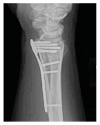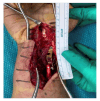Risk for Flexor Pollicis Longus Rupture after Volar Lock Plating for Distal Radius Fracture Lasts Over a Decade
- PMID: 39720543
- PMCID: PMC11664749
- DOI: 10.22038/ABJS.2024.77674.3587
Risk for Flexor Pollicis Longus Rupture after Volar Lock Plating for Distal Radius Fracture Lasts Over a Decade
Abstract
Objectives: Volar locking plate (VLP) fixation is a very common procedure due to the high incidence of distal radius fractures (DRFs). Attritional flexor tendon rupture is a rare, but recognized complication after VLP fixation. There is no current consensus to prevent the condition. Our objective was to highlight the long-term risk for flexor tendon rupture after VLP fixation.
Methods: We conducted a retrospective single-center review of patients with attritional flexor tendon rupture after VLP fixation for DRFs between 2016 and 2021. Patient demographics, DRF details including AO fracture classification, Soong grading and tendon reconstruction were collected. Thumb interphalangeal joint (IPJ) motion and Kapandji score were used as outcome measures for the tendon reconstruction.
Results: We identified five patients with attritional flexor pollicis longus (FPL) ruptures. The median age of the patients at the time of DRF was 48 (34-56) years. All VLP fixations were Soong grade 2. Median time from VLP fixation to tendon rupture was 7 (3-14) years. Longest surgery-to-rupture interval was 14 years. One rupture was treated conservatively. Four were reconstructed using palmaris longus (PL) tendon graft. Thumb IPJ active range of motion median was 48 (20-55) degrees and Kapandji score 9/10 (7-9/10).
Conclusion: Older generation VLP fixations with Soong grade 2 pose a long-term risk for attritional FPL rupture, which can be reconstructed with PL tendon graft with fair to good outcomes.
Keywords: Distal radius fracture; Flexor pollicis longus; Flexor tendon rupture; Tendon reconstruction; Volar locking plate fixation.
© 2024 Mashhad University of Medical Sciences.
Conflict of interest statement
The authors do NOT have any potential conflicts of interest with respect to this manuscript.
Figures


Similar articles
-
Management Options and Clinical Outcomes After Flexor Tendon Ruptures Following Volar Plating of Distal Radius Fractures.Hand (N Y). 2024 Nov 5:15589447241292654. doi: 10.1177/15589447241292654. Online ahead of print. Hand (N Y). 2024. PMID: 39501588 Free PMC article.
-
FPL Reconstruction After Rupture Following Volar Plate Fixation of Distal Radius Fractures: A Case Series.J Hand Surg Glob Online. 2025 Feb 7;7(3):100693. doi: 10.1016/j.jhsg.2025.01.002. eCollection 2025 May. J Hand Surg Glob Online. 2025. PMID: 40496413 Free PMC article.
-
Flexor Pollicis Longus Tendon Rupture after Distal Radius Volar Plating and Reconstruction with Interpositional Palmaris Tendon Graft: A Case Report.J Orthop Case Rep. 2025 Aug;15(8):91-95. doi: 10.13107/jocr.2025.v15.i08.5896. J Orthop Case Rep. 2025. PMID: 40786757 Free PMC article.
-
Flexor tendon rupture after volar plating of distal radius fracture: A systematic review of the literature.Hand Surg Rehabil. 2021 Oct;40(5):535-546. doi: 10.1016/j.hansur.2021.05.008. Epub 2021 May 24. Hand Surg Rehabil. 2021. PMID: 34033928
-
Hand Surgeon Reporting of Tendon Rupture Following Distal Radius Volar Plating.Hand (N Y). 2016 Sep;11(3):278-286. doi: 10.1177/1558944715620792. Epub 2016 Feb 19. Hand (N Y). 2016. PMID: 27698628 Free PMC article. Review.
References
-
- Court-Brown CM, Caesar B. Epidemiology of adult fractures: a review. Injury. 2006;37(8):691–7. - PubMed
LinkOut - more resources
Full Text Sources
